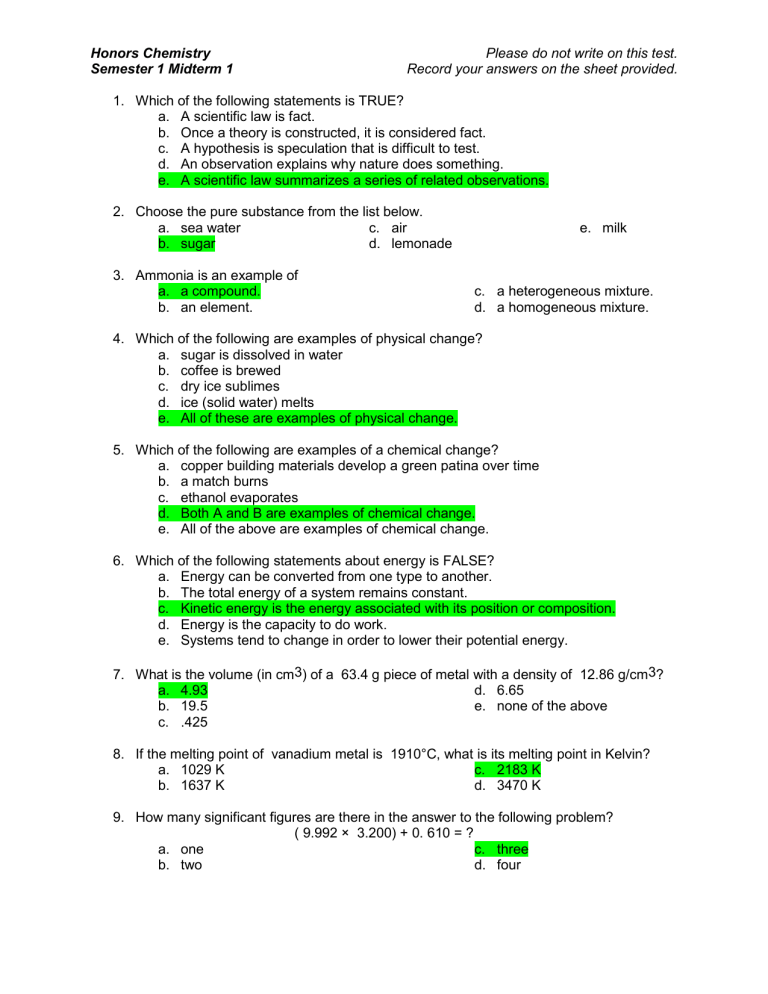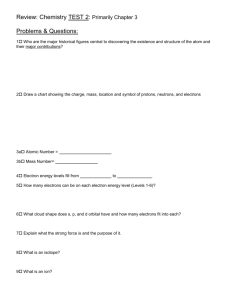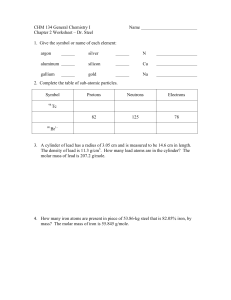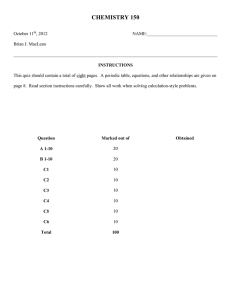Honors Chemistry Semester 1 Midterm Exam

Honors Chemistry
Semester 1 Midterm 1
1. Which of the following statements is TRUE? a. A scientific law is fact. b. Once a theory is constructed, it is considered fact. c. A hypothesis is speculation that is difficult to test.
Please do not write on this test.
Record your answers on the sheet provided.
d. An observation explains why nature does something. e. A scientific law summarizes a series of related observations.
2. Choose the pure substance from the list below. a. sea water b. sugar
3. Ammonia is an example of c. air d. lemonade e. milk a. a compound. b. an element. c. a heterogeneous mixture. d. a homogeneous mixture.
4. Which of the following are examples of physical change? a. sugar is dissolved in water b. coffee is brewed c. dry ice sublimes d. ice (solid water) melts e. All of these are examples of physical change.
5. Which of the following are examples of a chemical change? a. copper building materials develop a green patina over time b. a match burns c. ethanol evaporates d. Both A and B are examples of chemical change. e. All of the above are examples of chemical change.
6. Which of the following statements about energy is FALSE? a. Energy can be converted from one type to another. b. The total energy of a system remains constant. c. Kinetic energy is the energy associated with its position or composition. d. Energy is the capacity to do work. e. Systems tend to change in order to lower their potential energy.
7. What is the volume (in cm3) of a 63.4 g piece of metal with a density of 12.86 g/cm3? a. 4.93 d. 6.65 b. 19.5 c. .425 e. none of the above
8. If the melting point of vanadium metal is 1910°C, what is its melting point in Kelvin? a. 1029 K b. 1637 K c. 2183 K d. 3470 K
9. How many significant figures are there in the answer to the following problem?
( 9.992 × 3.200) + 0. 610 = ? a. one b. two c. three d. four
10. How many cm3 are contained in 3.77 × 104 mm3? a. 3.77 × 104 cm3 b. 3.77 × 101 cm3 c. 3.77 × 10-10 cm3 d. e.
3.77 × 1020 cm3
3.77 × 106 cm3
11. If 1.4% of the mass of a human body is calcium, how many kilograms of calcium are there in a 185-pound man? a. 1.2 kg Ca b. 5.7 kg Ca c. 1.2 × 102 kg Ca d. 5.7 × 102 kg
12. When two elements form two different compounds, the masses of element B that combine with 1 g of element A can be expressed as a ratio of small whole numbers.
Which law does this refer to? a. Law of Definite Proportions b. Law of the Conservation of
Mass c. Law of Modern Atomic Theory d. Law of Multiple Proportions e. First Law of Thermodynamics
13. Identify the description of an atom. a. neutrons and electrons in nucleus; protons in orbitals b. neutrons in nucleus; protons and electrons in orbitals c. protons and neutrons in nucleus; electrons in orbitals d. protons and electrons in nucleus; neutrons in orbitals e. electrons in nucleus; protons and neutrons in orbitals
14. What does "X" represent in the following symbol? a. silicon b. sulfur
28
14
X c. zinc d. ruthenium e. nickel
15. Determine the number of protons, neutrons and electrons in the following:
25
12
X a. p+ = 12 b. p+ = 12 c. p+ = 12 d. p+ = 25 n° = 25 n° = 12 n° = 13 n° = 12 n° = 13 e- = 12 e- = 13 e- = 12 e- = 13 e. p+ = 12 a. sodium e- = 25
16. What element is defined by the following information? p+ = 11 n° = 12 e- = 11 c. magnesium b. vanadium d. titanium
17. Predict the charge that an ion formed from sulfur would have. a. 1- c. 3- b. 6+ d. 4+ e. 2-
18. Which of the following statements is FALSE? a. Halogens are very reactive elements. b. The alkali metals are fairly unreactive. c. Sulfur is a main group element. d. Noble gases do not usually form ions. e. Zn is a transition metal.
19. Silver has an atomic mass of 107.868 amu. The Ag-109 isotope (108.905 amu) is
48.16%. What is the amu of the other isotope? a. 106.905 amu b. 106.908 amu c. 106.903 amu d. 106.911 amu
20. How many xenon atoms are contained in 2.36 moles of xenon? a. b.
3.92 × 1024 xenon atoms
2.55 × 1023 xenon atoms c. 1.42 × 1024 xenon atoms d. 7.91 × 1025 xenon atoms e. 1.87 × 1026 xenon atoms
21. What mass (in g) does 3.99 moles of Kr have? a. 334 g b. 476 g c. 211 g d. 240 g
22. How many Li atoms are contained in 97.9 g of Li? a. 5.90 × 1025 Li atoms b. 7.09 × 1021 Li atoms c. 8.49 × 1024 Li atoms
23. A covalent bond is best described as a. the sharing of electrons between atoms. b. the transfer of electrons. c. a bond between a metal and a nonmetal. d. a bond between a metal and a polyatomic ion. e. a bond between two polyatomic ions. d. e. e. 144 g
4.27 × 1022 Li atoms
4.18 × 1024 Li atoms
24. Identify the compound with ionic bonds. a. Ne c. O2 b. CO d. H2O e. K
25. Which of the following contains BOTH ionic and covalent bonds? a. RbI b. C
6
H
12
O
6 c. Na 3
PO
3 d. S 2
Cl
2
26. Give a possible molecular formula for C3H5ClO e. None of the above contain both ionic and covalent bonds. a. C6H10ClO2 b. C5H10Cl2O2 c. C6H10Cl2O2 d. C6H10O2 e. C6H12Cl2O2
27. What is the empirical formula for Hg2(NO3)2? a. Hg2(NO3)2 c. Hg(NO3)2 e. Hg4(NO3)4 b. HgNO3 d. Hg2NO3
28. Which of the following is a molecular element? a. Mg b. Ar c. Xe d. I
29. Which of the following is a molecular compound? a. NaCN b. LiOH c. SrI2 d. ZnS
30. Give the name for SnO. a. tin (I) oxide b. tin (II) oxide
31. Write the formula for barium nitrite. c. tin (III) oxide d. tin (IV) oxide e. Li e. P4O10 a. Ba3N2 c. BN e. B(NO2)3 b. BaNO3
32. Write the name for Sn(SO4)2. Remember that Sn forms several ions. a. tin (I) sulfite b. tin (IV) sulfate d. Ba(NO2)2 c. tin sulfide d. tin (II) sulfite e. tin (I) sulfate
33. Write the name for Ca3(PO4)2. a. calcium (III) phosphite b. calcium (II) phosphite c. calcium phosphate
34. Write the formula for copper (II) sulfate pentahydrate. d. tricalcium phosphorustetraoxide e. calcium phosphite d. (CuSO4)5 e. CuSO4∙5H2O a. Cu2SO3∙H5 b. Cu2S∙H2O c. CuS∙5H2O
35. Give the name for H2SO4. a. sulfuric acid b. persulfurous acid c. sulfurous acid
36. Calculate the molar mass of Ca3(PO4)2. a. 87.05 g/mol b. 215.21 g/mol c. 310.18 g/mol d. hyposulfurous acid e. persulfuric acid d. 279.21 g/mol e. 246.18 g/mol
37. How many molecules of N2O4 are in 76.3 g N2O4? The molar mass of N2O4 is 92.02 g/mol. a. 5.54 × 1025 N2O4 molecules b. 7.26 × 1023 N2O4 molecules c. 1.38 × 1024 N2O4 molecules d. e.
4.59 × 1025 N2O4 molecules
4.99 × 1023 N2O4 molecules
38. What is the mass (in kg) of 6.89 × 1025 molecules of CO2? The molar mass of CO2 is
44.01 g/mol. a. 3.85 kg b. 5.04 kg c. 2.60 kg d. 3.03 kg e. 6.39 kg
39. Calculate the mass percent composition of lithium in Li3PO4. a. 26.75 % b. 17.98 % c. 30.72 % d. 55.27 % e. 20.82 %
40. How many moles of N2O3 contain 2.55 × 1024 oxygen atoms? a. 1.41 moles N2O3 d. 7.87 moles N2O3 b. 4.23 moles N2O3 a. N2O3 b. N3O6 c. N2O4 d. NO2 e. 2.82 moles N2O3 c. 12.7 moles N2O3
41. Determine the molecular formula of a compound that has a molar mass of 92.0 g/mol and an empirical formula of NO2. e. N2O5
42. Determine the empirical formula for a compound that is found to contain 10.15 mg P and
34.85 mg Cl. a. P3Cl b. PCl c. PCl2 d. P2Cl3 e. PCl3
43. Determine the molecular formula of a compound that is 49.48% carbon, 5.19% hydrogen, 28.85% nitrogen, and 16.48% oxygen. The molecular weight is 194.19 g/mol. a. C8H12N4O2 b. C4H5N2O c. C8H10N4O2 d. C8H10N2O
44. Write a balanced equation to show the reaction of aqueous aluminum acetate with aqueous ammonium phosphate to form solid aluminum phosphate and aqueous ammonium acetate. a. Al(C2H3O2)2 (aq) + (NH4)2PO4 (aq) → AlPO4 (s) + 2 NH4C2H3O2 (aq) b. Al(C2H3O2)2 (aq) + (NH3)2PO4 (aq) → AlPO4 (s) + 2 NH3C2H3O2 (aq) c. Al(CO3)2 (aq) + (NH3)2PO4 (aq) → AlPO4 (s) + 2 NH3CO3 (aq) d. Al(C2H3O2)3 (aq) + (NH4)3PO4 (aq) → AlPO4 (s) + 3 NH4C2H3O2 (aq) e. Al(CO2)3 (aq) + (NH4)3PO3 (aq) → AlPO3 (s) + 3 NH4CO2 (aq)
1) Define an atom.
Answer: An atom is the submicroscopic particle that constitutes the fundamental building block of ordinary matter.
2) Define matter.
Answer: Matter is anything that occupies space and has mass.
3) Define energy.
Answer: Energy is the capacity to do work.
4) Define the law of the conservation of energy.
Answer: Energy is neither created or destroyed.
5) A flash drive contains 4 gigabytes. How many bytes does it contain?
Answer: 4,000,000,000 bytes or 4,292,967,296 byte if someone is computer literate
6) What happens to the density of a sample of iron metal as it is heated from room temperature to 100°C? (This is below the melting point of iron)
Answer: Since the mass of the iron stays constant, but the volume increases as the temperature is raised, the density of the iron decreases upon heating.
7) What does it mean to be an exact number? Give an example of an exact number.
Answer: An exact number has an infinite number of significant figures even though we typically don't write many of them out. If there are 26 people in a classroom, there are exactly 26.00000.... people in that room. There is no possibility of a half person, so this is an exact whole number with no ambiguity.
8) Describe an atom and what it is made up of according to modern atomic theory.
Answer: An atom is made up of a nucleus surrounded by electrons. The nucleus contains protons (positively charged particles) and neutrons (neutral particles) and is where most of the mass of an atom comes from, but is a tiny fraction of an atom's volume. The nucleus is surrounded by negatively charged electrons, the same number as there are protons in the nucleus. An atom is therefore neutral overall.
9) Why doesn't a mass spectrum of silver have a peak at 107.9 amu?
Answer: The average atomic mass of silver is 107.9 amu, but there are no atoms of silver that weigh 107.9 amu. One isotope weighs more and another weighs less.
10) Describe the difference between ions and isotopes.
Answer: Ions have the loss or gain of electrons; isotopes differ in the number of neutrons.
11) Why do elements in the same group tend to have similar chemical properties?
Answer: Since elements in the same group have the same number of valence electrons
(similar electron configurations) they tend to have similar chemical reactivity, since chemical reactions typically involve valence electrons.
12) What is significant about the number, 6.022 x 1023 ?
This is the number of particles in a mole, know as Avogadro’s number.
13) What is the structure of the covalent compound formed by nitrogen and oxygen? Is this the only possibility? Explain.
Answer: Since nitrogen and oxygen are both nonmetals, they combine by sharing electrons. This can be done in multiple different ways. Some possible compounds are
N2O, N2O3, NO2.
14) Which of the compounds C4H10, BaCl2, Ni(NO3)2, SF6 are expected to exist as molecules?
Answer: C
4
H
10
and SF
6
are composed of nonmetals and bonded covalently.
15) The chemical formula for nitrous acid is
Answer: nitrous acid is HNO2.
16) The molecular weight of urea ((NH2)2CO), a compound used as a nitrogen fertilizer, is
__60.1_ amu (rounded to one decimal place).
17) Calculate the mass percent composition of oxygen in Al2(SO4)3.
Answer: 56.11%
18) How many chloride ions are there in 4.50 mol of aluminum chloride?
Answer: 8.13 × 1024 chloride ions
19) Methane and oxygen react to form carbon dioxide and water. What mass of water is formed if 0.80 g of methane reacts with 3.2 g of oxygen to produce 2.2 g of carbon dioxide?
Answer: 1.8 g
20) What is the empirical formula of a substance that contains 2.64 g of C, 0.444 g of H, and
3.52 g of O?
Answer: C H2O
21) Balance the following equation:_2_C2H6O ( l ) + _12_O2( g ) → _4_CO2( g ) + _6_H2O( l )






